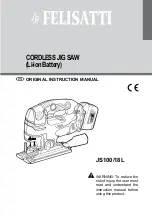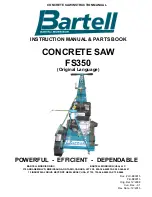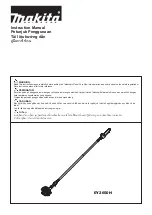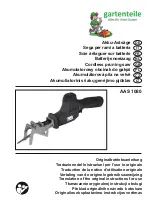
25
GB І 25
- Always remove the mains plug from the socket be-
fore adjusting settings or performing maintenance
and cleaning.
- Do not clamp the table saw protection when it is
folded out.
-
Only use the transport fixtures for transport; never
use the protective fixtures for handling or transport.
- During transport, always cover the top part of the
saw blade, for example with the saw blade guard.
- Only connect the table saw if the mains voltage of
the socket corresponds to the specification on the
nameplate.
- Only connect the table saw to an easily accessible
socket so that you can quickly disconnect the table
saw from the power supply in the event of a fault.
-
If an extension cord is required, make sure its diame
-
ter is sufficient to accommodate the power consump
-
tion of the table saw. Minimum diameter 1 mm
2
.
- Only use cable drums if the cable is completely
rolled out.
- Check the mains connection line. Do not use any
faulty or damaged mains connection lines.
- The table saw is equipped with a safety switch to
protect it against reactivation after a voltage drop.
- Never operate the table saw in wet rooms or in the
rain.
- If the mains connection line of the table saw is dam-
aged, it must be replaced by the manufacturer, its
after sales support or a similarly qualified person in
order to prevent risks.
- Never touch the mains plug with damp hands.
- Never pull the mains plug out of the socket by the
mains connection line; instead, always do so by
taking hold of the mains plug.
- Lay the mains connection line so that it does not
pose a tripping hazard.
- Do not kink the mains connection line and do not lay
it over sharp edges. Protect it from heat sources.
Supplementary safety instructions for the saw blades
- Do not use any damaged or deformed saw blades.
-
Do not use saw blades which exhibit cracks. Dis
-
pose of any cracked saw blades. It is not permis-
sible to repair them.
- Do not use any saw blades made of high speed
steel.
- Check the condition of the saw blades before you
use the table saw.
- Only use saw blades suitable for the material you
intend to cut.
-
Only use the saw blades specified by the manufac
-
turer. The saw blades must comply with EN 847-1
if they are intended for cutting wood or similar ma-
terials.
- Do not use saw blades made from high-alloyed
high speed steel (HSS).
-
Only use saw blades whose maximum permissible
speed is not less than the maximum spindle speed
of the table saw and suitable for the material you
intend to cut.
Supplementary safety instructions
Supplementary safety instructions for the table saw
The table saw must not be used by children or per-
sons with impaired physical, sensory or mental ca-
pacities or lack of experience and knowledge.
- The operator must be at least 18 years of age.
- Keep children away from the table saw. Make sure
children do not play with the table saw or insert any
objects into the table saw.
- Do not allow children to play with the packaging
wrapper. They may get caught in it when playing
and suffocate.
- Set up the table saw in a stable position.
- Ensure that the surfaces surrounding the table saw
are even, clean and free from loose particles and
cut debris.
- Safety devices on the table saw must not be re-
moved or dismantled.
- Wear personal protective gear when using the ta-
ble saw. These may include:
• Hearing protection to reduce the risk of suffering
hearing damage;
• Protective goggles to reduce the risk of wood
splinters going into your eyes;
• Respiratory protection to reduce the risk of inhal-
ing dust that is hazardous to health;
• Gloves when handling saw blades and rough
materials. It is recommended to store the saw
blades in a container to prevent injury.
- Avoid awkward hand positions where there is a risk
of suddenly slipping or both hands coming into con-
tact with the saw blade.
- When sawing, position yourself slightly to the side
and not straight in front of the saw blade.
-
Connect the table saw to a suitable dust extractor
when cutting wood. The table saw should only be
operated in closed rooms with a suitable dust ex
-
tractor.
- Promptly replace a worn or damaged table insert.
- Before beginning any job, ensure that the splitting
wedge and the saw blade protector are correctly
fitted, positioned and screwed in tightly.
- Use a push stick to push the workpiece through the
saw blade.
- Always keep the push stick in its holder when not
in use.
- For particularly long workpieces, always use an ad-
ditional support (table, stand etc.) to avoid the table
saw or the workpiece tipping over.
-
Always push the workpiece firmly against the table
saw and the end stop when sawing to prevent the
workpiece from turning over or wobbling.
- Do not try to cut rebates or grooves with the table
saw without fitting a suitable protective device, e.g.
a tunnel-type device, over the saw table.
- Do not use the table saw to cut slots (a groove end-
ing in the workpiece).
-
Do not use the table saw to cut firewood.
- Never remove loose splinters, chips or clamped-in
wood parts while the saw blade is running.
Summary of Contents for 5801304903
Page 2: ...2 9 1 10 N 2 17 A B 5 C D E 8 4 3 2 1 14 15 16 18 19 19 17 9 11 13 12 8 7 6 5 10 A 2 1...
Page 3: ...3 F D 1 E H J 7 8 M L 2 10 N 9 K G G 4 5 6 7 9 8 10 L 4 5 3 E...
Page 4: ...4 12 11 11 13 14 12 6 13 P 14 13 14 8 Q 8 Q 15 16 R R R R 18 3 B 6 C 17...
Page 5: ...5 19 4 S 20 max 3 5 mm 21 22 23 24...
Page 6: ...6 25 26 27 28...
Page 58: ...58...
Page 59: ...59...
Page 60: ...60...
Page 62: ...62...
















































